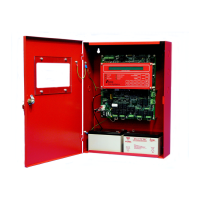August 2013 1-2 P/N 06-236530-001
The ARIES coordinates the operations of the varied components of a protected-premises fire
protection or notification system. These operations include:
• Interpreting initiating signals from automatic detectors or monitor modules. Initiating
signals can be any of the following:
– Automatic detector pre-alarm
– Automatic detector alarm
– Manual alarm
– Manual extinguishing-system release
– Extinguishing-system abort
– Sprinkler-system waterflow
– Sprinkler-system supervisory
– Point-specific trouble report
• Annunciating the initiating-device report, or any other system event, via the display and
associated peripheral annunciation equipment
• Notifying the occupants of an emergency situation
• Activating control equipment to aid with building evacuation or to prepare an area for
special-extinguishing-system discharge
• Discharging the special-extinguishing system, if necessary
• Actuating ancillary equipment to call the fire department
• Warning of any trouble condition that could inhibit alarm transmission or annunciation or
whose occurrence could prevent the system from carrying out its mission.
1-1.1 Standard Features
The following standard features are incorporated in the control unit's single-printed-
circuit-board design:
• One (1) signaling-line circuit (SLC) for Class-A, Style -6 or -7 or Class-B, Style-4
operation
• 255 intelligent-device capacity
• Two (2) notification-appliance circuits (NACs) for Class-A, Style-Z or Class-B,
Style-Y operation. Each NAC is capable of creating the following master-coded
patterns for audible notification appliances: 60 beats per minute (bpm), 120 bpm,
temporal pattern per ANSI S3.41, and steady activation.
• Two (2) releasing circuits for actuators or solenoid-operated control heads and
valves
• Two (2) field-configurable outputs for notification appliances or solenoid-operated
control heads and valves. Each output operates in Class-A, Style-Z or Class-B,
Style-Y manner when configured as a NAC, and is capable of creating the following
master-coded patterns for audible notification appliances: 60 beats per minute
(bpm), 120 bpm, temporal pattern per ANSI S3.41, and steady activation.
• One (1) unpowered, Form-C relay contact for trouble conditions
• Three (3) programmable, unpowered, Form-C relay contacts
• One (1) RS-485 communications circuit for remote-display units or
annunciator-driver modules
• One (1) USB-style communications port for device capability
• Two (2) RS-232 serial-style communications ports.
• One (1) network-interface-card connector for integration of up to 32 control units
in full peer-to-peer operation
• One (1) operator interface with 80-character liquid-crystal display, status-
indicating LEDs and control/numeric keys

